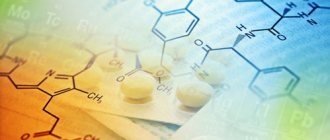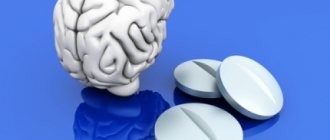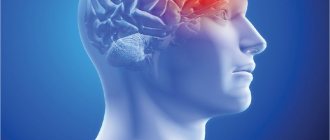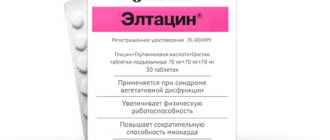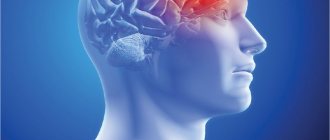Therapy of vegetative-vascular dystonia is a complex and lengthy process.
It is sometimes difficult for such patients to choose a truly effective remedy. Grandaxin for VSD helps eliminate the alarming symptoms of this complex, as well as other neurological disorders. The medicine is a relatively new product on the pharmaceutical market, but has already managed to prove itself on the positive side.
Description
Grandaxin is an anxiolytic drug or tranquilizer. Produced in 50 mg tablets. They have a round and flat shape, the color range varies from white to grayish. On one side there is a dividing line, on the other there is the Grandax logo.
The tablets are placed on a blister that holds 10 tablets. There are 2 or 6 pieces in a package.
The active substance of Grandaxin is represented by tofisopam. It is obtained by an atypical chemical modification of the diazepam molecule. Tofisopam belongs to the group of benzodiazepines and exhibits the properties of tranquilizers, but has some peculiarities.
All about the dosage form
Unfortunately, not all people carefully study the instructions for the drug when purchasing medications. But in vain. Even when products have the same active substance, their indications and method of use can be very different. And a clear example of this is the drug Glycine, which is produced by the company BIOTICS. The peculiarity of the amino acid is that it is poorly absorbed by the digestive system. If you take the drug by swallowing it with water, it will not have any effect. Glycine, which is produced by the BIOTICS company, is significantly different from other products. It's all about microencapsulation technology, which was developed and patented by the company (the RF patent number is indicated on each package).
Tranquilizers and Grandaxin
Tranquilizers are identical to the concept of anxiolytics. Translated from Latin, anxietas means fear or anxiety, and litikoc from ancient Greek means weakening. Thus, tranquilizers are designed to relieve anxiety.
Anxiolytics are called minor tranquilizers, while antipsychotics are classified as major tranquilizers. Most of them exhibit 5 main effects:
- anxiolytic - elimination of emotional stress, obsessive thoughts and fears, reduction of anxiety;
- sedative - removal of psychomotor excitability, slowing down activity, speed of reactions, both mental and motor. Decreased concentration;
- sleeping pills - normalization of sleep, increasing its depth;
- muscle relaxant - muscle relaxation. May be accompanied by lethargy, weakness, slow reaction, excessive relaxation;
- anticonvulsant - reduction of excitation in epileptoid foci of the brain.
Grandaxin is also a representative of tranquilizers. However, it does not exhibit a pronounced sedative, muscle relaxant and anticonvulsant effect, but has mainly an anti-anxiety effect.
Tranquilizers in neurology: pro and contra
Galina Mikhailovna Dyukova, neurologist, MD, professor of the Department of Nervous Diseases of the Federal Faculty of Physics, Moscow Medical Academy named after. I. M. Sechenov.
Tranquilizers are one of the most frequently prescribed drugs in neurological practice, but neither doctors nor patients should forget that they must be taken with great caution.
The World Health Organization does not recommend the use of tranquilizers for long-term treatment, as they can lead to physical dependence. The duration of treatment with tranquilizers should not exceed 1 month. However, WHO recommendations state that tranquilizers are used only for symptomatic and additional treatment.
Due to their wide range of clinical effects, tranquilizers are used in neurology to treat a number of syndromes:
- psycho-vegetative disorders (permanent and panic);
- pain syndromes (acute and chronic);
- sleep disorders and parasomnia (bruxism, sleepwalking, nightmares, movement disorders: restless legs syndrome, myoclonus, periodic leg movements in sleep, etc.);
- extrapyramidal disorders (tremor, dystonia, myoclonus);
- epileptic disorders (epileptic seizures);
- diseases of the neuromuscular system (rigid person syndrome).
Panic disorders
Tranquilizers are used to treat panic disorders only in the following cases:
1. As first aid to relieve a panic attack.
2. As a drug for course monotherapy, if:
- the duration of the disease is insignificant;
- agoraphobic syndrome and depression are absent.
3. If therapy with antidepressants is impossible due to:
- patient's reluctance;
- intolerance to antidepressants due to side effects;
- In case of combination of panic disorder with epileptic syndromes.
4. In combination with antidepressants:
- as an adjuvant to accelerate the clinical effect,
- for the correction of anxiety and panic disorders, the intensification of which is provoked by the start of taking antidepressants;
- if the dose of an antidepressant is insufficient, and its increase is limited by side effects.
Pain
Tranquilizers are used in neurology to treat both acute and chronic pain. They have a muscle relaxant, analgesic and anti-anxiety effect, due to which their therapeutic effect is formed and the prevention of chronic pain is ensured.
Dream
A number of benzodiazepine tranquilizers have a hypnotic effect and are used as hypnotics. Among them:
- midazolam (Dormikum),
- brotizolam (Lendormin),
- triazolam (Halcion),
- nitrozepam (Radedorm Eunoctin),
- flunitrozepam (Rohypnol),
- bromazepam (Lexotan),
- flurazepam (Dalmadorm).
The first three drugs have the shortest half-life, so they are the most effective and safe as a sleep aid.
Negative aspects of using tranquilizers
Tranquilizers may cause hypersedation. Its main symptoms are: daytime sleepiness, muscle relaxation, lethargy, unsystematic dizziness, psychomotor retardation, decreased concentration and reaction speed. In young people, hypersedation leads to decreased activity and causes difficulties in driving and performing professional duties. In old age, especially with cerebrovascular insufficiency, taking tranquilizers can lead to impaired coordination of movements, ataxia, disorientation and confusion.
In some patients, tranquilizers cause “paradoxical reactions,” that is, instead of a calming effect, they increase aggressiveness, agitation, and sleep disturbances. This effect is typical for impulsive and psychopathic individuals, patients who abuse alcohol or are prone to loss of self-control. In these cases, it is preferable to prescribe antipsychotics.
When taking tranquilizers, physical and psychological dependence can develop, up to the formation of substance abuse. The degree of risk of addiction depends on the drug, its dose, duration of use, withdrawal strategy and the personality of the patient. The risk increases in individuals prone to alcohol abuse, spontaneous increases in doses, and long-term and continuous use of the drug.
If the drug is prescribed incorrectly or is discontinued, o.s. syndrome may develop.
Withdrawal syndrome occurs when there is a sharp decrease in the concentration of the drug in the blood. At the same time, anxiety, irritability, insomnia, weakness, headache, muscle twitching and muscle pain, tremors, sweating, dizziness, nausea, loss of appetite, hypersensitivity to sensory stimuli, impaired perception, depersonalization, and sometimes confusion increase. To avoid withdrawal syndrome, the drug should be gradually withdrawn.
Predictors of withdrawal syndrome are:
- age over 60 years,
- a history of withdrawal symptoms after treatment with other drugs,
- long duration of treatment,
- rapid withdrawal of a high daily dose.
A “rebound phenomenon” may occur with the use of short-acting benzodiazepines. It is manifested by the appearance of anxiety and other symptoms of the disease in the intervals between doses of the drug. To avoid the “rebound phenomenon,” it is recommended to take the drug more frequently or replace it with a long-acting drug.
Features of the tranquilizer "Grandaxin"
Tofisopam (trade name Grandaxin) belongs to the group of benzodiazepine tranquilizers. Is a 2-3 benzodiazepine. Potentiates the binding of other (endogenous) benzodiazepines to benzodiazepine receptors.
Grandaxin has been known to neurologists for quite a long time - since the 80s of the last century. During this time, it has established itself as a drug with unique clinical properties:
- It does not have a sedative-hypnotic effect, but has a slight stimulating effect.
- Does not cause muscle relaxant effect.
- Particularly effective against autonomic disorders that accompany anxiety.
- It has very low toxicity and mild side effects.
- Does not cause either physical or mental dependence.
- There is no development of tolerance to the drug.
- No withdrawal syndrome noted.
In Russia, with the participation of Professor G. M. Dyukova, a large multicenter study was conducted on the effectiveness and tolerability of the tranquilizer Grandaxin (tofisopam) for psychovegetative disorders. The study involved 270 patients aged 18 to 55 years from 11 cities in Russia. The main group (n=162) took Grandaxin at a dose of 150 mg/day, the control group included 108 people.
A 28-day course of therapy with Grandaxin allowed to normalize psycho-vegetative imbalance, increase activity, quality of sleep and life of the subjects. In both groups, treatment had a positive effect on anxiety, however, in the main group, the anxiolytic effect was achieved already by the 2nd week of treatment, in contrast to patients in the control group, which was subjectively perceived by patients as an improvement in well-being, regression of the disease. During therapy with Grandaxin, there was a significant decrease in the level of autonomic dysfunction, noted by the patients themselves and according to objective assessments by doctors.
The supposed psychostimulant effect of Grandaxin was not confirmed by the study data. There was no need to reduce the dose or move it to the morning. An improvement in the quality of night sleep was noted in patients taking Grandaxin, which makes it possible to prescribe it to patients suffering from psychovegetative disorders in combination with insomnia disorders.
Thus, the good tolerability of the drug Grandaxin and the absence of adverse events during treatment allows the drug to be used at a dose of 150 mg/day in patients with both an isolated psycho-vegetative symptom complex and concomitant somatic and neurological pathologies.
How the drug works
When treated with Grandaxin, there is no drowsiness or lethargy. Moreover, it moderately increases mental and motor activity, stimulates mental activity, and provides a surge of strength and energy.
The drug does not cause muscle relaxation, eliminates the feeling of fatigue and increases performance. It returns sound and healthy sleep, but there is no lethargy or drowsiness during the day. In general, this drug does not have the side effects that are inherent in many tranquilizers.
Taking Grandaxin for VSD provides a vegetative stabilizing effect.
Our autonomic system regulates the activity of internal organs, as well as blood vessels. It consists of the sympathetic and parasympathetic divisions. If the balance in their work is disturbed, there is, accordingly, a failure in the regulation of the work of those systems for which they are responsible. Such violations can manifest themselves in different ways:
- tachycardia, pain and compression in the heart area;
- difficulty breathing, shortness of breath, feeling of lack of air;
- feeling of a lump in the throat;
- sweating, low-grade fever;
- redness of the skin, feeling of heat;
- headache, dizziness;
- asthenia, malaise;
- fear of death or concerns about one's health.
A similar symptom complex is a manifestation of vegetative-vascular dystonia.
Grandaxin helps to establish a synergistic effect of both parts of the autonomic nervous system, eliminates most symptoms of VSD, relieves apathy, anxiety, phobias and obsessive thoughts.
Outpatient and inpatient treatment
The Mental Health Clinic successfully combines the treatment of panic attacks both with medication and through psychotherapy. Most often, treatment for panic attacks is carried out on an outpatient basis, but there are also options for inpatient placement. The attending physician will select an antidepressant that will help relieve acute symptoms and draw up a treatment plan, including the prevention and relief of possible recurrences of panic attacks. Patients who clearly know how to help themselves when the disease manifests itself experience significantly less fear of the manifestation of a crisis, which reduces general anxiety and raises the emotional background in general. However, the most important psychiatric help for panic attacks is to conduct active psychotherapeutic work with the patient. This will allow you to find the root cause of the disease and, by completely eliminating it, get rid of the disease forever.
We can help you! Call us
Other indications
Grandaxin is effective not only for VSD, but also for neuroses, as well as other similar conditions. Indications include:
- alcohol withdrawal;
- premenstrual, menopausal period;
- mental maladjustment;
- mild depression;
- conditions accompanied by muscle asthenia and atrophy, when muscle relaxant anxiolytics are unacceptable for use.
The drug is a daytime tranquilizer. It does not cause addiction or withdrawal symptoms.
An important property of Grandaxin is the relief of panic attacks. This is a feeling that occurs suddenly or under the influence of a stressful situation. Accompanied by a strong feeling of fear and vegetative disorders.
The concepts of VSD and panic attack are closely related: the attack is a kind of exacerbation of neurocirculatory dystonia. Therefore, therapy for these conditions follows a similar plan.
What is a panic attack
A panic attack is an attack of sudden fear and severe anxiety for no apparent reason.
The origins of panic disorder are not completely clear. However, it is believed that the disease has a genetic predisposition and more often affects the fair sex. Women are more prone to panic attacks and suffer from this disorder 2-3 times more often than men. Panic attacks cannot lead to death, despite the fact that this is the feeling that most often accompanies them. The more often attacks occur, the worse the quality of life becomes. People who have repeatedly experienced panic attacks become increasingly anxious and subconsciously try to avoid places or situations where and when they succumbed to fear. Those who have at least once experienced an attack at night subsequently experience sleep disorders.
Features of use
Grandaxin is taken 1-2 tablets 1 to 3 times a day. The course of treatment is based on the severity of the manifestations and is prescribed exclusively by a doctor. A maximum of 300 mg of the drug per day is allowed.
Like any medicinal component, Grandaxin can lead to adverse reactions and intolerance by the body. They are manifested by the following violations:
- allergic rash and itching;
- pain and increased muscle tone;
- labored breathing;
- irritability and agitation, sleep disturbance, clouding of consciousness, headaches, exacerbation of epilepsy.
In case of an overdose of the drug, the development of a coma and breathing problems, depression of the central nervous system is possible.
Grandaxin should not be used for obsessive states and persistent psychoses. This will lead to a suicide attempt and increased aggression.
If you are allergic to lactose, the drug is also contraindicated, since each tablet contains about 90 mg of this substance.
The drug is not prescribed for respiratory disorders.
The drug should not be prescribed in the first 3 months of pregnancy and during breastfeeding.
The drug is prescribed with caution to patients with epilepsy, personality disorders and organic damage to the central nervous system, as well as elderly people, patients with mental retardation and decreased kidney function.
When the drug enters the intestines, it is quickly absorbed. Its highest concentration in the blood appears after a few hours. The active ingredient is not concentrated in the body. Most of it is excreted in urine, and a small amount is excreted in feces.
Grandaxin has some peculiarities of contact with other drugs. Its combination together with certain immunosuppressants (tacrolimus), as well as with cyclosporine, increases their accumulation in the blood.
Grandaxin enhances the intensity of the action of psychotropic drugs: sedatives, hypnotics and antidepressants.
In turn, its intensity of impact is increased by antihypertensive drugs, and accumulation in the blood is intensified by antimycotic drugs.
The combined use of Grandaxin and antacids reduces its absorption.
Anxiolytic mitigates the toxic effects of alcohol-containing drinks on the central nervous system. But its parallel use with these liquids, barbiturates, antiepileptic drugs, nicotine reduces its effectiveness.
Why does panic disorder develop?
Many experts believe that at least once in their life everyone experiences symptoms similar to a panic attack. But the majority do not focus on them; a pathological reaction is not triggered.
Panic attacks can also occur against the background of various somatic and functional disorders and psychopathologies.
The causes vary as much as the severity of the symptoms. If we summarize all the available data, we can identify several main triggers:
- A long stay in a psychotraumatic situation is stress at work or study, which the body expresses with the help of psychosomatics.
- Secondary benefit - often a panic attack carries some benefit: by feeling unwell, the patient avoids any tasks or responsibilities. Sometimes the presence of such a benefit is itself the cause of the disorder.
- Somatic diseases. Often the symptoms of the disorder are caused by diseases of the endocrine system.
Treatment is aimed at both relieving symptoms and eliminating the underlying cause. Therefore, first of all, the specialist will try to find out what led to the unpleasant symptoms.
